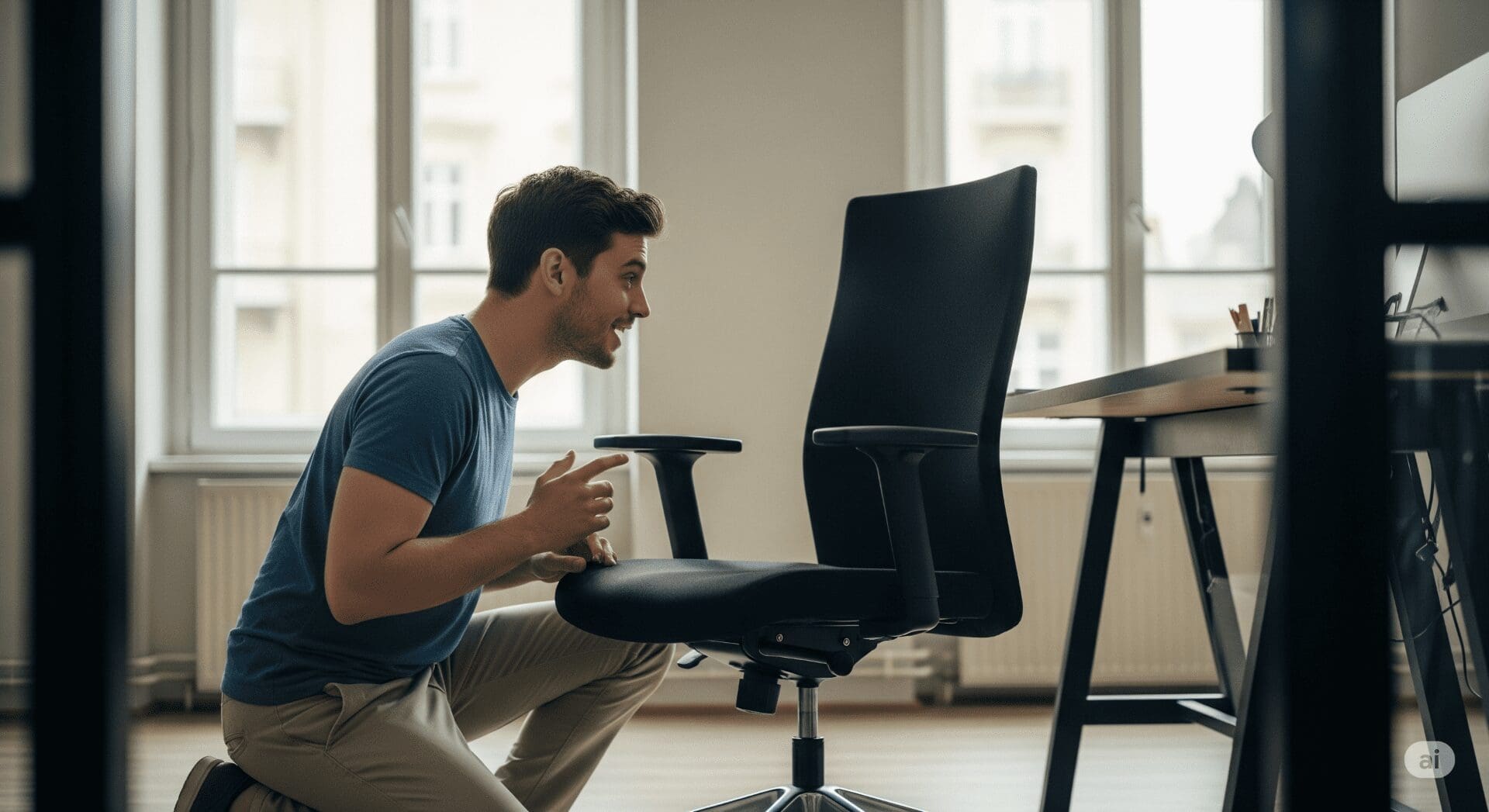Your Desk Chair is Your Life Coach: Ergonomics, Posture, and the Psychology of How You Sit.
We often think of life coaches as wise mentors, guiding us through challenges, helping us unlock potential, and pushing us towards our best selves. But what if I told you that one of the most profound, yet overlooked, life coaches in your daily existence is sitting right beneath you? It’s your desk chair.
Yes, that humble piece of furniture, often taken for granted, holds the key to not just physical comfort, but also to your mental well-being, your productivity, and ultimately, the quality of your life. It’s a silent, steadfast companion, constantly reflecting back to you the habits you embody, the care you give yourself, and the energy you project into the world.
The Slouch, The Strain, and The Silent Scream
Think about it. For many of us, our desk chair is where we spend a significant portion of our waking hours. We work, we create, we learn, we connect. Yet, how often do we truly listen to what our chair is telling us?
Perhaps you know the feeling: the creeping ache in your lower back by midday, a tension headache tightening around your temples, shoulders hunched forward as if carrying the weight of the world, a stiff neck that makes turning your head feel like a monumental effort. These aren’t just physical discomforts; they are the silent screams of a body out of alignment, and they resonate deeply within your mind.
When your body is in pain, your focus shatters. That brilliant idea you were chasing? It gets lost in the fog of discomfort. Your patience wears thin. Creativity feels like a distant memory. The simple act of sitting, which should be a foundation for productive work, becomes a source of drain, a constant battle against your own physiology. This isn’t just about feeling bad; it’s about being less. Less effective, less joyful, less present.
The Epiphany: A Chair’s Gentle Nudge
My own journey to understanding this profound connection began not with a grand revelation, but with a persistent, nagging pain. My back felt like a perpetual knot, my energy levels plummeted by early afternoon, and I found myself irritable and distracted. I blamed long hours, stress, anything but the obvious. Then, a friend, a seasoned ergonomist, simply watched me sit.
“Your chair isn’t just a place to rest,” she said, “it’s an extension of your intention. Right now, your intention seems to be to disappear into yourself.”
Her words hit me. My posture was indeed a physical manifestation of my mental state: hunched, defensive, trying to shrink from the demands of the day. It was a vicious cycle: poor posture led to physical discomfort, which led to mental fatigue, which reinforced the poor posture.
That day, my desk chair stopped being just a chair. It became my first, gentle life coach.

The Coaching Session: Ergonomics 101
Here’s what my chair, guided by my friend, taught me about its fundamental principles – the ergonomic pillars that support not just your spine, but your entire being:
- The Foundation: Feet Flat, Knees at 90 Degrees.
- Instruction: Adjust your chair height so your feet are flat on the floor or a footrest, with your knees bent at approximately a 90-degree angle. Your thighs should be parallel to the floor.
- The “Why”: This creates a stable base, distributing your weight evenly and reducing pressure on your lower back and hips. It’s like building a house on solid ground; without it, everything else is precarious. Mentally, this stability translates to groundedness and a sense of being firmly rooted, ready to tackle tasks without feeling off-balance.
- The Support System: Lumbar Love.
- Instruction: Your chair should have good lumbar support that fits the natural curve of your lower back. If it doesn’t, use a small cushion or rolled towel.
- The “Why”: Your spine has a natural S-curve. Lumbar support helps maintain this curve, preventing slouching and reducing strain on the discs and ligaments in your lower back. When your spine is properly supported, your body feels less fatigued, allowing your mind to remain alert and focused. It’s like having a strong, unwavering ally always behind you, literally and figuratively.
- The Armrests: Shoulder Relaxation.
- Instruction: Adjust your armrests so your arms can rest gently, with your elbows at roughly a 90-degree angle, close to your body.
- The “Why”: This takes the strain off your shoulders and neck, preventing tension headaches and upper back pain. When your shoulders are relaxed, your breathing deepens, and your entire upper body feels lighter. Psychologically, this release of tension in the shoulders can feel like shedding a heavy burden, freeing up mental space for clarity and ease.
- The Gaze: Eye-Level Horizon.
- Instruction: Position your monitor so the top of the screen is at or slightly below eye level, about an arm’s length away.
- The “Why”: This prevents you from craning your neck up or down, which can lead to neck pain and eye strain. A level gaze promotes an open, alert posture, mirroring a mind that is open and receptive. When your eyes are comfortable, your mind can process information more efficiently, reducing mental fatigue.
- The Tools: Keyboard and Mouse Harmony.
- Instruction: Keep your keyboard and mouse close to your body, allowing your wrists to remain straight and relaxed, not bent up or down.
- The “Why”: This minimizes repetitive strain injuries (RSIs) in your wrists and forearms. When your hands and wrists are comfortable, your interaction with your work tools feels seamless, reducing minor irritations that can accumulate into significant mental distractions.
The Psychology of the Sit: Beyond the Physical
As I began to implement these changes, the physical relief was immediate. But what truly astonished me was the ripple effect on my mental and emotional landscape.
- Clarity from Alignment: When my spine was aligned, it felt as if my thoughts became clearer. The mental fog that used to descend mid-afternoon began to lift. It was as if the physical alignment created a channel for mental clarity.
- Energy from Ease: Less pain meant less energy spent fighting discomfort. This freed up a tremendous amount of mental energy, which I could now direct towards creative problem-solving, deeper focus, and genuine engagement with my work. I felt more vibrant, even after long hours.
- Confidence from Openness: A slumped posture is often a sign of defensiveness, low energy, or even self-doubt. When I sat up straight, shoulders back, chest open, I naturally felt more confident, more capable, more “ready.” This wasn’t just an external appearance; it was an internal shift. My body was signaling to my brain: “I am present. I am capable. I am open.”
- Resilience from Comfort: The constant micro-stressors of physical discomfort erode your resilience. When your body is comfortable, your capacity to handle external stressors increases. You become less reactive, more patient, and more adaptable. Your chair, in its quiet way, was teaching me resilience.
- Mindfulness in Motion: The act of consciously adjusting my posture throughout the day became a form of mindfulness. Each time I straightened up, I was pulling myself back into the present moment, checking in with my body, and reaffirming my commitment to my well-being. This simple act became a powerful anchor in a busy day.
Your Chair, Your Ally, Your Future Self
Your desk chair isn’t just a piece of furniture; it’s a silent witness to your struggles and triumphs. It’s a tool that, when used wisely, can profoundly impact your physical health, mental acuity, and emotional state. It’s a daily invitation to practice self-care, to embody confidence, and to create an environment that fosters your best work and your happiest self.
So, take a moment. Right now. Feel how you are sitting. Is your chair coaching you towards slouching, pain, and distraction? Or is it gently guiding you towards alignment, comfort, and boundless potential?
Adjust your chair. Align your spine. Open your chest. Let your desk chair be the life coach it was always meant to be. Because how you sit isn’t just about your body; it’s about how you show up for your life, one conscious, comfortable, and powerful sit at a time.


